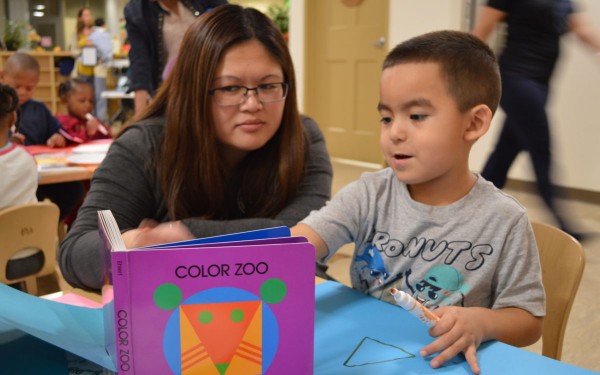
Photo: Zaidee Stavely/EdSource
Preschool teacher Rosa Bounkhoune listens to a child talk about shapes at the Lighthouse for Children Child Development Center in Fresno.
By Zaidee Stavely/EdSource
This story was first published on EdSource.
A group of California parents and preschool teachers are overcoming their fear of math and discovering new confidence to teach it to young children through an unexpected source: storybooks.
A series of activities designed to teach math concepts inspired by children’s books are being piloted in Fresno as part of the California Statewide Early Math Initiative, which aims to improve how preschool teachers and parents teach and talk about math concepts with young children. At an event to kick off the project, preschoolers and parents at the Lighthouse for Children Child Development Center built boats with aluminum foil, modeling clay and popsicle sticks, and then placed them in water to see if they would float. Other children traced and cut out shapes from construction paper and glued them down to create animals, or counted and played with colorful plastic balls to see how many would fit in different containers.
The Lighthouse for Children Child Development Center is run by the Fresno County Superintendent of Schools, which is leading the statewide initiative, funded through an $11.2 million grant from the California Department of Education.
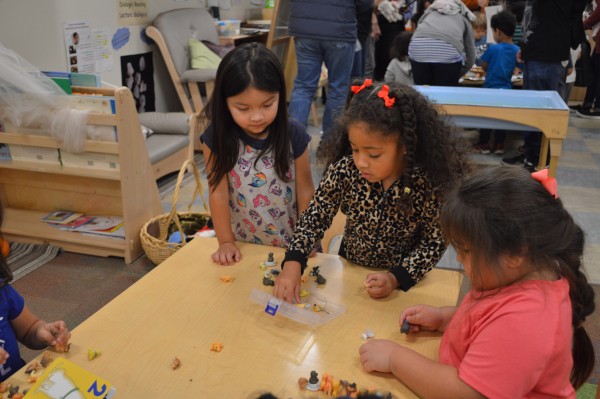
Photo: Zaidee Stavely/EdSource
Children sort toy animals at a family math night at Lighthouse for Children Child Development Center in Fresno.
A large body of research has shown that when children understand preschool-level math concepts before they enter kindergarten, they perform better on math and reading tests in later years. But many children in California enter kindergarten behind in math, partly because many preschool teachers and parents feel insecure about their own math skills.
Pairing math games with children’s books is a way to get more parents and preschool teachers involved in teaching math through an activity they tend to be more comfortable with — reading.
“Many parents feel quite comfortable reading with their children, and because it’s something they feel really comfortable with, they engage with their kids by reading more often,” said Carolyn Pfister, an education administrator for the State Board of Education who helped develop the materials. “They’re more inclined to think of math instruction and comprehension as the domain of the school rather than the domain of the home.”
Pfister and her colleagues have so far developed math games and discussion questions for about 50 children’s books. Some books have an obvious number theme — counting ducks, for example, or a story about a child saving money. The math in other books is less obvious. For example, “The Birthday Box” is about a child who plays with a cardboard box — pretending it is an airplane, or making it into a robot costume. The math activity suggested for this book is that teachers and parents can have children play with a box or another container and put balls or other objects inside, on top and under the box to learn about counting, quantities and space and location.
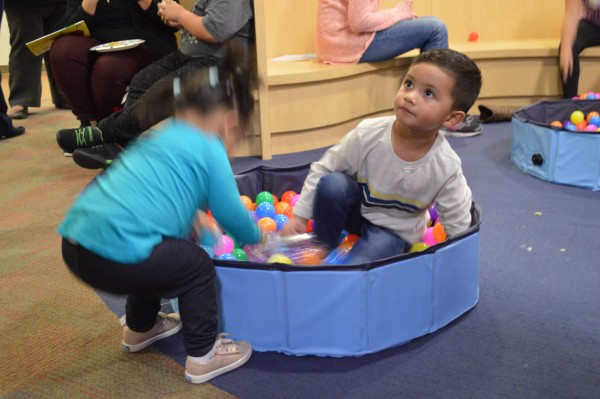
Photo: Zaidee Stavely/EdSource
Children play in mini ball pits as part of a math activity at the Lighthouse for Children Child Development Center in Fresno.
At the family math night in Fresno, children jumped and played in two small padded pools filled with colorful plastic balls. Infant-and-toddler lead teacher Rachel Siapin asked them if they could find all the red balls and put them in a clear plastic bowl. “There’s still space,” she said. “It’s not quite full yet. Are there more red balls?”
“Things you may not know are math, especially in infancy, are simple things like they dump all the toys out of the basket, or they bang two toys together: math,” Siapin said. “Also just using number concept words, like asking for more or saying all done, just kind of the understanding that there is more, or there is less.”
“We really wanted to make sure that it was clear that math is everywhere, math is fun, it’s not something that’s just contained in a textbook or a classroom, and it’s not something that any one type of person can do or not do,” said Matilda Soria, director of early care and education for the Fresno County Superintendent of Schools.
The math games go beyond counting, even for books that focus on that concept. The book “Doggies” explores counting by beginning with the words “One dog. Woof!,” continuing with “Two dogs. Woof woof!,” and so on. To go along with this book, children at the event in Fresno sorted different-colored dogs into different rows and practiced repeating sound patterns with bells and rattles made out of plastic bottles.
As her 3-year-old daughter shook a plastic bottle filled with beads, Michelle Lopez said she was surprised by the use of everyday materials.
“I never thought of putting beads or anything in a water bottle, and anybody can do that, so that’s a great idea,” she said.
Vanessa Lozano was at the Fresno event with her 2-year-old son Cesar.
“I thought math was strictly, ‘Let’s count, let’s identify numbers.’ But it’s so much more than that,” she said. “My husband was quick to point out that a lot of what the presenters were talking about we do at home, so we were teaching math without even knowing it.”
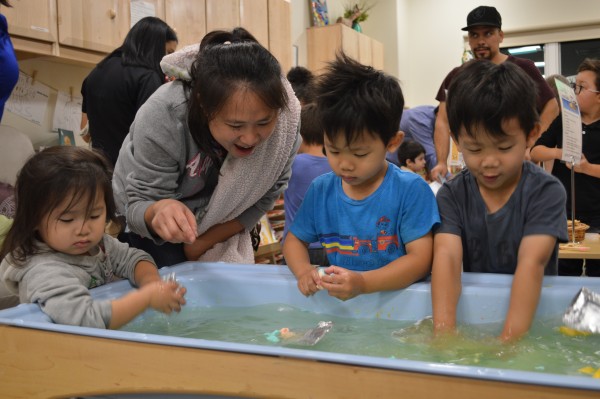
Photo: Zaidee Stavely/EdSource
Children test out boats made of modeling clay and aluminum foil at the Lighthouse for Children Child Development Center in Fresno.
The resources are available online for free for anyone to use in their own classrooms or homes. Soon, the Lighthouse for Children will also be allowing parents to check out free backpacks containing a children’s book and math activity.
“We really wanted to make sure that it was clear that math is everywhere, math is fun, it’s not something that’s just contained in a textbook or a classroom, and it’s not something that any one type of person can do or not do,” said Matilda Soria, director of early care and education for the Fresno County Superintendent of Schools.
The Early Math Initiative is also developing a series of short videos in English and Spanish about math for young children. The AIMS Center for Math and Science Education, a nonprofit organization also based in Fresno that helps teachers learn how to teach math and science, is sending coaches to teach early childhood directors and teachers from across the state how to incorporate math into their daily activities. They kicked off the program with what they called an “institute,” a week-long session on teaching math to children 0-8 years old.
“We’re finding especially among the early care and education workforce, there’s a lot of studies that show that there’s that fear” of teaching math, Soria said. “We heard a lot, especially at the beginning of the institute, ‘I always thought you had to have a special type of brain to do math.’ And at the end we heard, ‘I discovered I’m a math person.’”
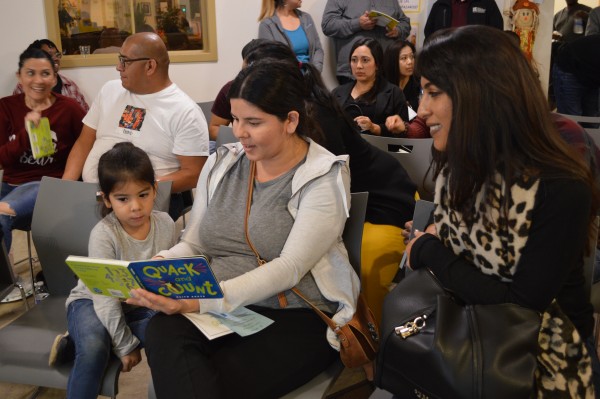
Photo: Zaidee Stavely/EdSource
Madres leen un libros de matemáticas a niños aprendices, en la escuela Lighthouse for Children Child Development Center, en Fresno, CA.
Maritza Ceballos, the lead teacher in the Spanish-English dual immersion preschool classroom at Lighthouse for Children Child Development Center, was one of those who was unsure about teaching math before she participated in the AIMS center program.
“I was fearful. ‘How am I going to teach the children mathematics when I don’t consider myself strong in math?’” Ceballos said. “That [week of classes] really opened my eyes as to everybody is good at math. I’m not as fearful now.”
Lighthouse for Children Child Development Center now serves as a demonstration site for other preschool teachers and college students who want to find out how to teach early math. Ceballos and other teachers there say they now use math intentionally all day.
After parents and preschool teachers in Fresno try out the math games that go with children’s books and give their feedback, the Early Math Initiative will make any changes needed, translate the materials into Spanish and promote them to child care centers and school districts throughout the state.













